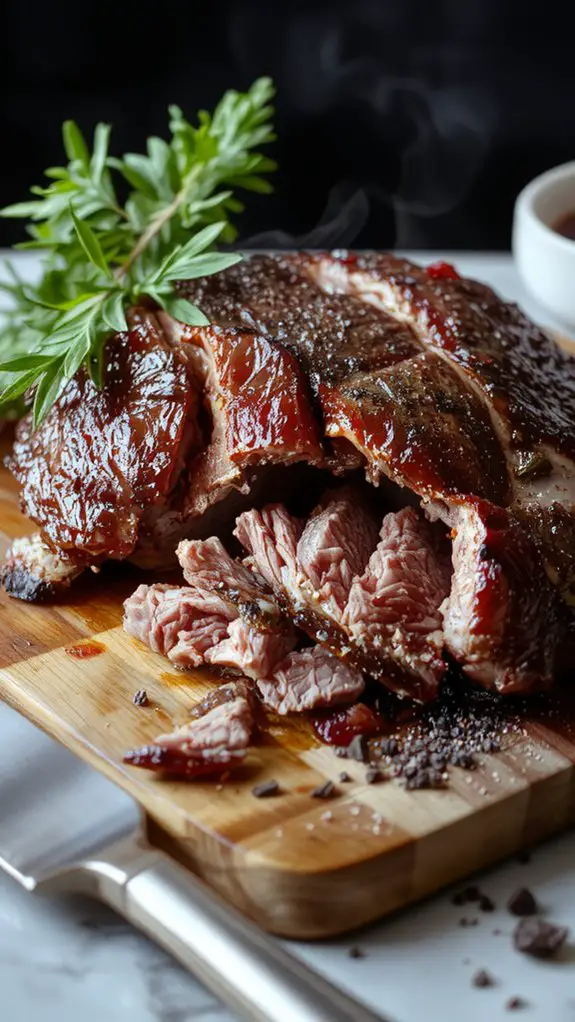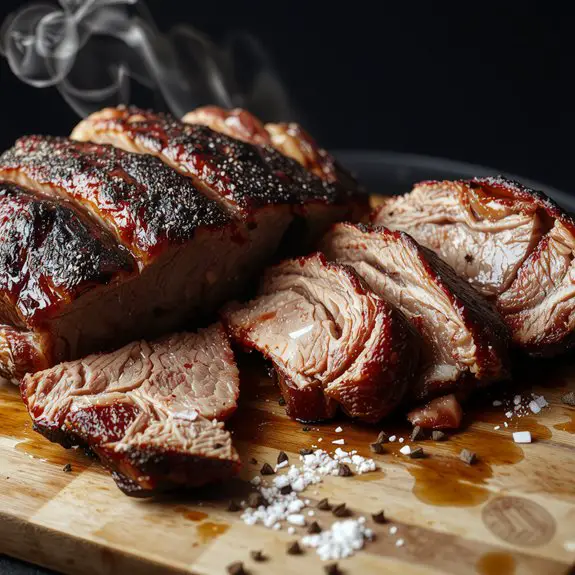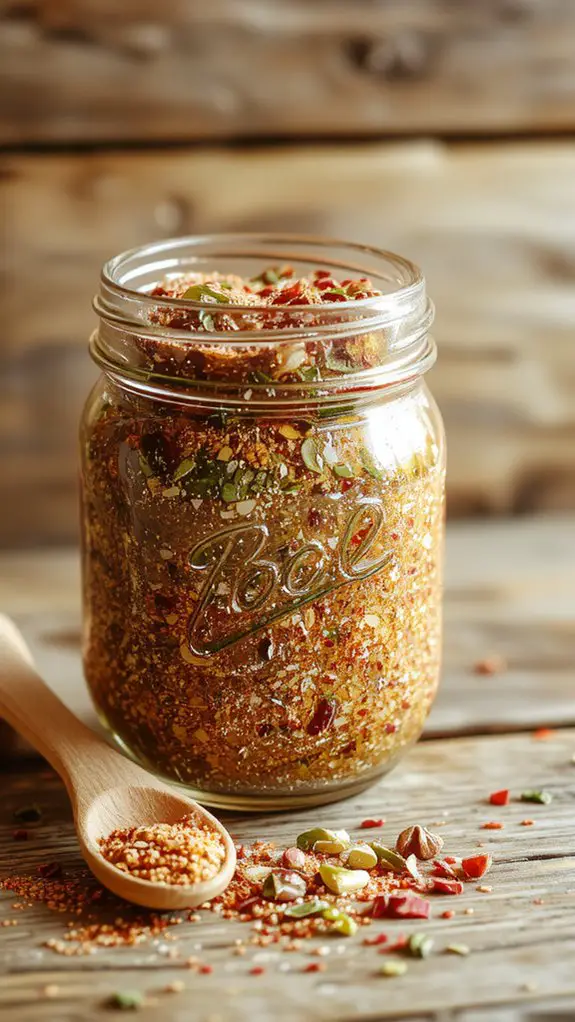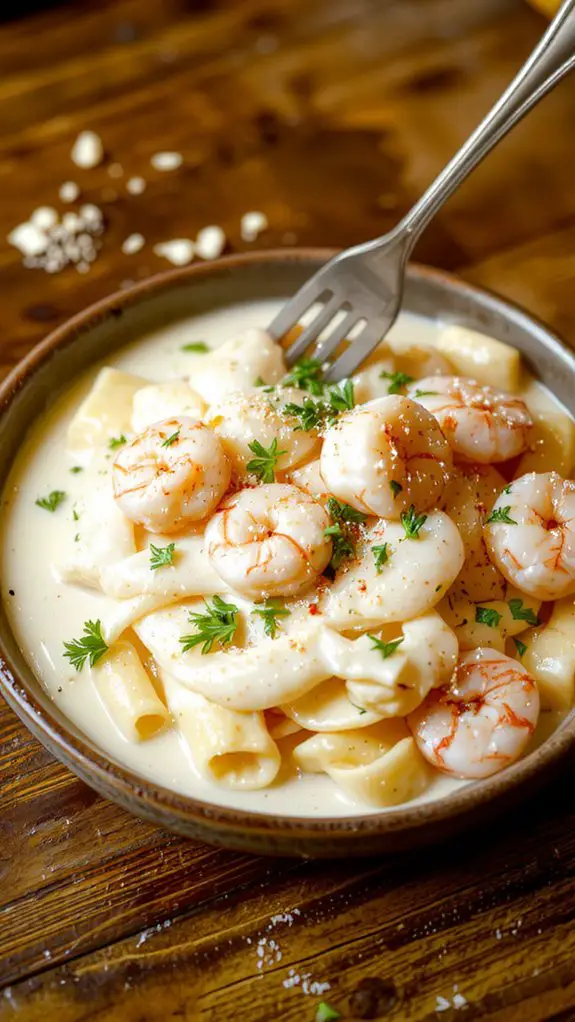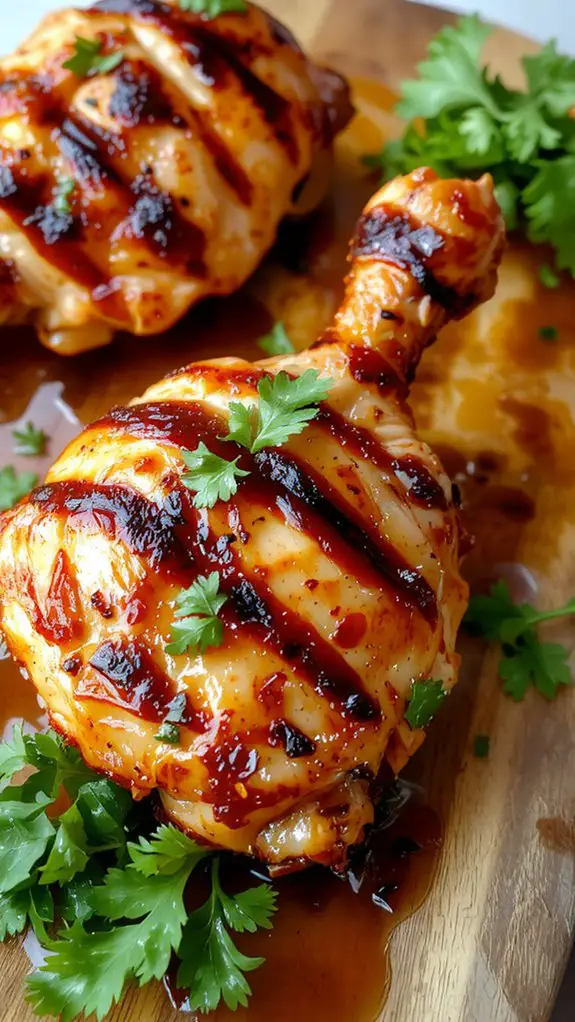Recipe
There’s nothing quite like the melt-in-your-mouth magic of a perfectly cooked brisket—and trust me, this recipe delivers every single time. Whether you’re a seasoned pitmaster or a first-time smoker, this method guarantees juicy, tender meat with a smoky bark that’ll have everyone begging for seconds.
The secret? A simple yet powerful dry rub that lets the beef shine, plus low-and-slow cooking that transforms tough cuts into buttery perfection. Imagine this: a deep mahogany crust giving way to succulent, pull-apart slices with just the right amount of smoky sweetness.
It’s the kind of dish that turns weeknight dinners into celebrations and makes you the hero of any backyard BBQ. And the best part? It’s way easier than you think—just patience, good ingredients, and a little love.
Let’s get cooking.
Ingredients
When crafting the perfect brisket, the ingredients you choose can make or break the dish. Opt for quality here—trust me, it matters. Let’s break it down so you can nail this recipe with confidence.
- Brisket (5-6 pounds): Look for a well-marbled cut with a thick fat cap. This melts down during cooking, keeping the meat juicy and flavorful. If you can’t find brisket, chuck roast is a solid substitute, though slightly richer in flavor.
- Kosher Salt: Coarse grains help draw out moisture and create a beautiful crust. Table salt will work, but reduce the amount by half to avoid over-salting.
- Black Pepper: Freshly ground is a must—it’s aromatic and packs a punch. Pre-ground pepper just doesn’t hit the same.
- Garlic Powder: Adds depth without burning like fresh garlic would. If you’re a garlic lover, feel free to double it.
- Onion Powder: Provides a subtle sweetness that complements the beef. No onion powder? Finely grated fresh onion works, but use sparingly to avoid excess moisture.
- Paprika: Smoked paprika is ideal for that extra layer of flavor. Sweet paprika can substitute if needed, but you’ll miss that smoky edge.
- Mustard Powder: This secret weapon enhances the crust and adds complexity. No mustard powder? A tablespoon of Dijon mustard mixed into the rub works in a pinch.
- Brown Sugar: Just a touch balances the savory notes. Light or dark brown sugar both work, but dark adds a richer molasses flavor.
- Beef Broth (2 cups): Keeps the brisket moist during the long cook. Low-sodium is best to control the salt level.
- Apple Cider Vinegar (1/4 cup): Adds acidity to cut through the richness. White vinegar or even a splash of red wine vinegar can substitute in a pinch.
- Worcestershire Sauce (2 tbsp): Umami booster—don’t skip it! Soy sauce can stand in if you’re out, but reduce the amount to avoid overpowering the dish.
- Optional: Wood Chips (hickory or oak): For smoking enthusiasts, these add a killer smoky flavor. No smoker? Liquid smoke (just a teaspoon) can mimic the effect.
Pro tip: Trim excess fat from the brisket, but leave about 1/4 inch—this renders down during cooking and keeps the meat tender.
And don’t skimp on the rub—it’s your flavor foundation. A little extra time seasoning pays off big in the end!
How to Make the Best Smoked Brisket Recipe

- Trim excess fat from the brisket, leaving about 1/4 inch to guarantee it stays moist during cooking. Pro Tip: Use a sharp knife and work slowly to avoid cutting into the meat.
- Season generously with salt, pepper, and your favorite dry rub, making sure to coat all sides evenly. Why It Matters: This step builds flavor and forms a delicious crust during smoking.
- Preheat your smoker to 225°F and place the brisket fat-side up on the grate. Watch-Out: Maintain a consistent temperature to avoid overcooking or drying out the meat.
- Smoke the brisket for 4-6 hours, or until it reaches an internal temperature of 165°F. Visual Cue: The brisket should have a deep mahogany color and a firm bark.
- Wrap the brisket in butcher paper or aluminum foil to lock in moisture and continue smoking. Pro Tip: Butcher paper allows the bark to stay crisp while keeping the meat tender.
- Smoke until the internal temperature reaches 195-203°F, which is the ideal range for tender, pull-apart brisket. Why It’s Key: This guarantees the collagen breaks down properly, resulting in a melt-in-your-mouth texture.
- Remove from the smoker and let it rest for at least 1 hour before slicing. Watch-Out: Cutting too soon can cause the juices to escape, leaving the brisket dry.
- Slice against the grain for maximum tenderness. Pro Tip: Identify the grain direction before cooking to make slicing easier later.
- Serve immediately with your favorite sides and sauces. Flexibility: Brisket pairs well with coleslaw, pickles, or a tangy barbecue sauce.
Nutrition
Brisket is a nutritious dish packed with protein and essential nutrients. Here’s the nutritional breakdown per serving (based on a typical recipe):
| Nutrient | Amount |
|---|---|
| Calories | 400 |
| Protein | 35g |
| Fat | 25g |
| Carbohydrates | 5g |
| Cholesterol | 90mg |
| Sodium | 600mg |
Chef Tips
To achieve the perfect brisket, I always recommend starting with a quality cut of meat. Trim excess fat but leave a thin layer to keep it moist. Season generously and let it sit overnight for deeper flavor.
Cook low and slow—around 225°F—until tender. Wrap it in foil or butcher paper halfway through to lock in moisture. Rest it before slicing against the grain for the best texture.
Frequently Asked Questions
Can I Use a Gas Smoker for Brisket?
Yes, I can use a gas smoker for brisket. I just need to maintain a steady temperature around 225°F and add wood chips for smoke flavor. It might take time, but I can achieve tender, smoky results.
What’s the Best Wood for Smoking Brisket?
I’d use oak or hickory for smoking brisket because they give a strong, smoky flavor that complements the meat. Sometimes I’ll mix in some fruitwood like apple or cherry to add a touch of sweetness.
How Do I Store Leftover Brisket?
I wrap leftover brisket tightly in foil or plastic wrap, then place it in an airtight container or resealable bag. I store it in the fridge if I’ll eat it soon or freeze it for later.
Can I Freeze Smoked Brisket?
I can freeze smoked brisket—it’s a great way to keep it fresh longer. I’ll wrap it tightly in foil or plastic, then seal it in an airtight container or freezer bag to prevent freezer burn.
Why Is My Brisket Tough After Smoking?
I’m guessing your brisket’s tough because it wasn’t cooked long enough at a low temp or didn’t reach the internal temp of 195-205°F. It needs time to break down the collagen into tender, juicy meat.

